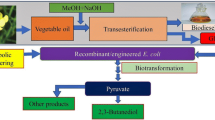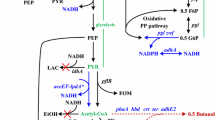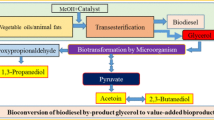Abstract
Microbial conversion is an important technology for the refinement of renewable resources. Here, we describe the biotechnological conversion of glycerol to 2-amino-1,3-propanediol (serinol), a relevant intermediate in several chemical syntheses processes. Either the dihydroxyacetone phosphate aminotransferase/dihydrorhizobitoxine synthase (RtxA) of Bradyrhizobium elkanii USD94 or only the N-terminal domain (RtxA513) comprising the first reaction, respectively, was expressed in recombinant Escherichia coli. Serinol contents of up to 3.3 g/l were achieved in batch cultures. We could further clarify that glutamic acid is the preferred cosubstrate for the transamination of dihydroxyacetone phosphate to serinolphosphate, which is the essential step in serinol synthesis. An in vivo detoxification of serinol employing wax ester synthase/acyl-CoA:diacyl-glycerol acyl transferase from Acinetobacter baylyi ADP1 was not accomplished. This study paves the way for biotechnological production of serinol from glycerol derived from the biodiesel industry.



Similar content being viewed by others
References
Aboulmagd E, Oppermann-Sanio FB, Steinbüchel A (2000) Molecular characterization of the cyanophycin synthetase from Synechocystis sp. strain PCC6308. Arch Microbiol 174:297–306
Alvarez HM, Steinbüchel A (2002) Triacylglycerols in prokaryotic microorganisms. Appl Microbiol Biotechnol 60:367–376
Bin Kim O, Luftmann H, Steinbüchel A (2009) Biotransformation of glycidol by the unspecific wax ester synthase/acyl-CoA:diacylglycerol acyltransferase of Acinetobacter baylyi ADP1. Eur J Lipid Sci Technol 111:972–978
Bullock WO, Fernandez JM, Short JM (1987) XL1-blue: high effiency plasmid transforming recA Escherichia coli strain with β-galactosidase selection. Biotechniques 5:376–378
Cameron DC, Altaras NE, Hoffman ML, Shaw AJ (1998) Metabolic engineering of propanediol pathways. Biotechnol Prog 14:116–125
Cheng HP, Wu SH, Wang KT (1994) D-Aminoacylase from Alcaligenes faecalis possesses novel activities on D-methionine. Bioorg Med Chem 2:1–5
Coenye T, Vancanneyt M, Cnockaert MC, Falsen E, Swings J, Vandamme P (2003) Kerstersia gyiorum gen. nov., sp. nov., a novel Alcaligenes faecalis-like organism isolated from human clinical samples, and reclassification of Alcaligenes denitrificans Ruger and Tan 1983 as Achromobacter denitrificans comb. nov. Int J Syst Evol Microbiol 53:1825–1831
Darabantu M (2010a) (Masked)serinol: molecules, biomolecules, building-block, supramolecules. Part (I): syntheses based on serinols’ reactivity with carbonyl electrophiles. Curr Org Synth 7:120–152
Darabantu M (2010b) (Masked)serinol: molecules, biomolecules, building-block, supramolecules. Part (II): serinolic approaches in current organic synthesis. Curr Org Synth 7:235–275
Darabantu M, Mager S, Plé G, Puscas C (1995) Heterocyclic saturated compounds as derivatives or precursors of chloromycetine and some related structures. Heterocycles 41:2327–2356
Fedoronko M, Petrusova M, Alfoldi J (1989) Electroreduction of triose oximes. Chem Pap Chem Zvesti 43:335–341
Felder E, Bianchi S, Bollinger H (1985) Process for the preparation of serinol and of serinol derivatives, and products obtained therefrom. US patent 4,503,252 (A)
Felder E, Römer M, Bardonner H, Härtner H, Fruhstorfer W (1987) Verfahren zur Herstellung von Hydroxyaminen. European patent 0238961 (A2)
Fitzpatrick TB, Amrhein N, Kappes B, Macheroux P, Tews I, Raschle T (2007) Two independent routes of de novo vitamin B6 biosynthesis: not that different after all. Biochem J 407:1–13
Hermann T (2003) Industrial production of amino acids by coryneform bacteria. J Biotechnol 104:155–172
Holtzapple E, Schmidt-Dannert C (2007) Biosynthesis of isoprenoid wax ester in Marinobacter hydrocarbonoclasticus DSM 8798: identification and characterization of isoprenoid coenzyme A synthetase and wax ester synthases. J Bacteriol 189:3804–3812
Itoh N, Yachi C, Kudome T (2000) Determining a novel NAD(+)-dependent amine dehydrogenase with a broad substrate range from Streptomyces virginiae IFO 12827: purification and characterization. J Mol Catal B: Enzym 10:281–290
Kalscheuer R, Stöveken T, Malkus U, Reichelt R, Golyshin PN, Sabirova JS, Ferrer M, Timmis KN, Steinbüchel A (2007) Analysis of storage lipid accumulation in Alcanivorax borkumensis: evidence for alternative triacylglycerol biosynthesis routes in bacteria. J Bacteriol 189:918–928
Kodali DR (2008) Glycerol derivatives and methods of making same. WO2008147671 (A2)
Korz DJ, Rinas U, Hellmuth K, Sanders EA, Deckwer WD (1995) Simple fed-batch technique for high cell density cultivation of Escherichia coli. J Biotechnol 39:59–65
Kovach ME, Elzer PH, Hill DS, Robertson GT, Farris MA, Roop RM, Petetson KM (1995) Four new derivatives of the broad-host-range cloning vector pBBR1MCS, carrying different antibiotic-resistance cassettes. Gene 166:175–176
Laemmli UK (1970) Cleavage of structural proteins during the assembly of the head of bacteriophage T4. Nature 227:680–685
Lowry OH, Rosebrough NJ, Farr AL, Randall RJ (1951) Protein measurement with the Folin phenol reagent. J Biol Chem 193:265–275
Manilla-Pérez E, Lange AB, Hetzler S, Steinbüchel A (2010) Occurrence, production, and export of lipophilic compounds by hydrocarbonoclastic marine bacteria and their potential use to produce bulk chemicals from hydrocarbons. Appl Microbiol Biotechnol 86:1693–1706
McCoy M (2006) Glycerin surplus. Chem Eng News 84:7–8
Michaelis M, Geisslinger G, Scholich K (2009) 2-Amino-1,3-propanediol compounds for the treatment of acute pain. US patent 2004248988 (A1)
Mitchell RE, Frey EJ, Benn MK (1986) Rhizobitoxine and 1-threo-hydroxythreonine production by the plant pathogen Pseudomonas andropogonis. Phytochemistry 25:2711–2715
Moriguchi M, Sakai K, Miyamoto Y, Wakayama M (1993) Production, purification, and characterization of D-aminoacylase from Alcaligenes xylosoxydans subsp. xylosoxydans A-6. Biosci Biotech Biochem 57:1149–1152
Nardi A, Villa M (1999) Process for the preparation of 2-amino-1,3-propanediol. US patent 5,922,917 (A)
Noble MEM, Zeelen JP, Wierenga RK, Mainfroid V, Goraj K, Gohimont AC, Martial JA (1993) Structure of triosephosphate isomerase from Escherichia coli determined at 2.6 Å resolution. Acta Crystallogr Sect D: Biol 49:403–417
Okazaki S, Sugawara M, Minamisawa K (2004) Bradyrhizobium elkanii rtxC gene is required for expression of symbiotic phenotypes in the final step of rhizobitoxin biosynthesis. Appl Environ Biotechnol 70:535–541
Overhage J, Priefert H, Rabenhorst J, Steinbüchel A (1999) Biotransformation of eugenol to vanillin by a mutant of Pseudomonas sp. strain HR199 constructed by disruption of the vanillin dehydrogenase (vdh) gene. Appl Microbiol Biotechnol 52:820–828
Owens LD, Thompson JF, Pitcher RG, Williams T (1972) Structure of rhizobitoxine, an antimetabolic enol-ether amino-acid from Rhixobium japonicum. J Chem Sci Chem Commun 1972:714
Pfeiffer H (1980) Process for the preparation of serinol (1,3-dihydroxy-2-aminopropane). US patent 4,221,740 (A)
Piloty O, Ruff O (1897) Ueber einige Aminoalkohole der Fettreihe. Ber Dtsch Chem Ges 30:2057–2068
Quirk JM, Harsy SG, Hakansson CL (1989) Novel process for the preparation of serinol. European patent 0348223 (A2)
Ruan X, Peters NK (1992) Isolation and characterization of rhizobitoxine mutants of Bradyrhizobium japonicum. J Bacteriol 174:3467–3473
Ruan X, Zhang C, Peters NK (1993) Bradyrhizobium japonicum rhizobitoxine genes and putative enzyme functions: expression requires a translational frameshift. Proc Natl Acad Sci USA 90:2641–2645
Sambrook J, Fritsch EF, Maniatis T (1989) Molecular cloning: a laboratory manual, 2nd edn. Cold Spring Harbor Laboratory, Cold Spring Harbor
Singh OV, Kampf DJ, Han HS (2004) Oxazine formation by MsCl/Et3N as a convenient tool for the stereochemical interconversion of the hydroxyl group in N-acetyl 1,3-aminoalcohols. Asymmetric synthesis of N-acetyl L-xylo- and L-arabino-phytosphingosines. Tetrahedron Lett 45:7239–7242
Smith DR, Doucette-Stamm LA, Deloughery C, Lee HM, Dubois J, Aldredge T, Bashirzadeh R, Blakely D, Cook R, Gilbert K, Harrison D, Hoang L, Keagle P, Lumm W, Pothier B, Qiu D, Spadafora R, Vicare R, Wang Y, Wierzbowski J, Gibson R, Jiwani N, Caruso A, Bush D, Safer H, Patwell D, Prabhakar S, McDougall S, Shimer G, Goyal A, Pietrovski S, Church GM, Daniels CJ, Mao JI, Rice P, Nolling J, Reeve JN (1997) Complete genome sequence of Methanobacterium thermoautotrophicum deltaH: functional analysis and comparative genomics. J Bacteriol 179:7135–7155
Stanley D, Bandara A, Fraser S, Chambers PJ, Stanley GA (2010) The ethanol stress response and ethanol tolerance of Saccharomyces cerevisiae. J Appl Microbiol 109:13–24
Stein S, Levitsky A, Fateev O, Mallard G (1998) The NIST mass spectral search program. Windows-Software Version 1.6d
Steinbüchel A, Valentin HE (1995) Diversity of bacterial polyhydroxyalkanoic acids. FEMS Microbiol Lett 128:219–228
Stöveken T, Kalscheuer R, Malkus U, Reichelt R, Steinbüchel A (2005) The wax ester synthase/acyl coenzyme A:diacylglycerol acyltransferase from Acinetobacter sp. strain ADP1: characterization of a novel type of acyltransferase. J Bacteriol 187:1369–1376
Tabor S, Richardson CC (1985) A bacteriophage T7 RNA polymerase/promoter system for controlled exclusive expression of specific genes. Proc Natl Acad Sci USA 82:1074–1078.
Tanaka T, Yamamoto S, Taniguchi M, Hayashi H, Kuramitsu S, Kagamiyama H, Oi S (1992) Further studies on aspartate aminotransferase of thermophilic methanogens by analysis of general properties, bound cofactors, and subunit structures. J Biochem 112:811–815
Thewalt K, Bison G, Egger H (1984) Process for the preparation of 2-aminopropanediol-1,3 (serinol). US patent 4,448,999 (A)
van Berkum P (1990) Evidence for a third uptake hydrogenase phenotype among the soybean bradyrhizobia. Appl Environ Microbiol 56:3835–3841
Villa M, Paiocchi M (2003) Process for the purifying of iopamidol. US patent 6,506,938 (B1)
Yang YB, Hsiao KM, Li H, Tsugita A, Tsai YC (1992) Characterization of D-aminoacylase from Alcaligenes denitrificans DA181. Biosci Biotech Biochem 56:1392–1395
Yasuta T, Okazaki S, Mitsui H, Yuhashi KI, Ezura H, Minamisawa K (2001) DNA Sequence and mutational analysis of rhizobitoxine biosynthesis genes in Bradyrhizobium elkanii. Appl Environ Microbiol 67:4999–5009
Yazdani SS, Gonzalez R (2008) Engineering Escherichia coli for the efficient conversion of glycerol to ethanol and co-products. Metabol Eng 10:340–351
Yuhaschi KI, Ichikawa N, Ezura H, Akao S, Miniakawa Y, Nukui N, Yasuta T, Minamisawa K (2000) Rhizobitoxine production by Bradyrhizobium elkanii enhances nodulation and competitveness on Macroptilium atropurpureum. Appl Environ Microbiol 66:2658–2663
Weber K, Osborn M (1969) The reliability of molecular weight determinations by dodecyl sulfate-polyacrylamide gel electrophoresis. J Biol Chem 244:4406–4412.
Acknowledgments
Financial support from the BMVEL/FNR (FKZ 22015806, 06NR158) is gratefully acknowledged. B. elkanii USD94 was provided by Dr. Perry Cregan (US Department of Agriculture, Beltsville, USA).
Author information
Authors and Affiliations
Corresponding author
Rights and permissions
About this article
Cite this article
Andreeßen, B., Steinbüchel, A. Biotechnological conversion of glycerol to 2-amino-1,3-propanediol (serinol) in recombinant Escherichia coli . Appl Microbiol Biotechnol 93, 357–365 (2012). https://doi.org/10.1007/s00253-011-3364-6
Received:
Revised:
Accepted:
Published:
Issue Date:
DOI: https://doi.org/10.1007/s00253-011-3364-6




